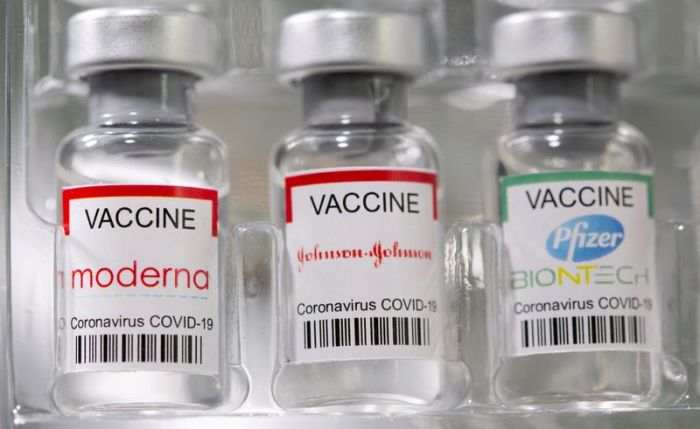By Gertrude Chavez-Dreyfuss
NEW YORK (Reuters) -The U.S. dollar climbed to a three-month peak on Tuesday in a flight-to-safety bid, as investors remained anxious about a fast-spreading coronavirus variant that could throttle global growth.
Commodity currencies tied to risk appetite such as the Australian and New Zealand dollars struggled, with investors opting for safety or staying on the sidelines amid renewed fears about the highly contagious Delta variant, now the dominant coronavirus strain worldwide.
U.S. infections have surged, especially in areas where vaccinations have lagged.
The dollar rose as yield differentials have moved against it. Benchmark 10-year U.S. Treasury yields dipped to a five-month low below 1.20% on Monday on renewed skepticism about a strong economic rebound from the pandemic. [US/]
“Shifts in relative growth rate expectations are weakening capital flows out of the U.S. and heightening the appeal of dollar-denominated investments,” said Karl Schamotta, chief market strategist at Cambridge Global Payments in Toronto.
“At the same time, an unwinding in speculative positions is forcing a short squeeze in currency markets – driving the dollar upward,” he added.
In afternoon trading, the dollar index, a measure of its value against six major currencies, rose 0.1% to 92.961, after hitting a three-month high of 93.161 earlier in the session.
Data showing U.S. housing starts rose 6.3% to a seasonally adjusted annual rate of 1.643 million units last month had little reaction from the FX market.
“I believe the safe-haven strengthening in the dollar is merited, considering that global progress has been anemic to what it appeared like in Q1 so now all valuations and high expectations for growth are being rightly questioned,” said Juan Perez, FX strategist and trader at Tempus Inc in Washington.
In other currencies, the euro weakened 0.2% to $1.1780, after dipping to $1.1755, the lowest since early April ahead of a European Central Bank policy decision on Thursday.
The British pound was also among the biggest losers, with the currency declining 0.4% to $1.3607, as Boris Johnson’s “freedom day” – ending more than a year of COVID-19 lockdown restrictions in England – was marred by surging infections.
The Australian dollar dropped to its lowest since late November and was last down 0.2% at US$0.7331.
The Aussie’s losses were broad-based as minutes of the Reserve Bank of Australia’s policy meeting this month were seen by some economists as a sign that the central bank may reverse a decision to taper stimulus.
In cryptocurrencies, bitcoin sank as low as $29,296.39, a level not seen since June 22. It was last down 3.4% at $29,779. Rival ether fell 1.5% to $1,789.32.
========================================================
Currency bid prices at 2:51PM (1851 GMT)
Description RIC Last U.S. Close Pct Change YTD Pct High Bid Low Bid
Previous Change
Session
Dollar index 92.9550 92.8770 +0.10% 3.305% +93.1720 +92.7990
Euro/Dollar $1.1783 $1.1800 -0.14% -3.56% +$1.1803 +$1.1755
Dollar/Yen 109.8250 109.4550 +0.34% +6.29% +109.9500 +109.3350
Euro/Yen 129.40 129.15 +0.19% +1.95% +129.4600 +128.6100
Dollar/Swiss 0.9211 0.9181 +0.34% +4.12% +0.9232 +0.9174
Sterling/Dollar $1.3627 $1.3673 -0.34% -0.26% +$1.3689 +$1.3573
Dollar/Canadian 1.2695 1.2746 -0.40% -0.31% +1.2787 +1.2695
Aussie/Dollar $0.7331 $0.7348 -0.24% -4.71% +$0.7357 +$0.7300
Euro/Swiss 1.0853 1.0831 +0.20% +0.43% +1.0857 +1.0822
Euro/Sterling 0.8645 0.8626 +0.22% -3.27% +0.8669 +0.8621
NZ $0.6922 $0.6944 -0.32% -3.61% +$0.6954 +$0.6882
Dollar/Dollar
Dollar/Norway 9.0055 8.9560 +0.56% +4.88% +9.1020 +8.9545
Euro/Norway 10.6140 10.5575 +0.54% +1.40% +10.7038 +10.5326
Dollar/Sweden 8.7038 8.6857 +0.08% +6.19% +8.7336 +8.6761
Euro/Sweden 10.2553 10.2475 +0.08% +1.78% +10.2692 +10.2380
(Reporting by Gertrude Chavez-Dreyfuss; Editing by Dhara Ranasinghe, Alex Richardson and Richard Chang)



















